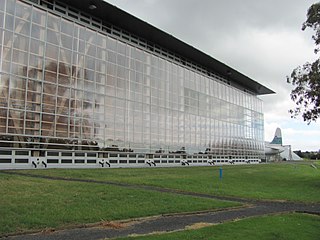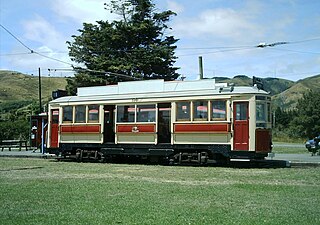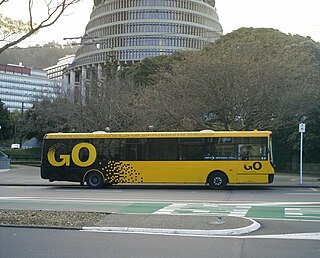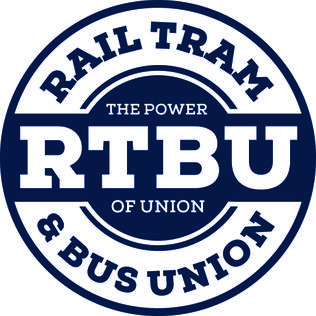
Rail transport in New Zealand is an integral part of New Zealand's transport network, with a nationwide network of 4,375.5 km (2,718.8 mi) of track linking most major cities in the North and South Islands, connected by inter-island rail and road ferries. Rail transport in New Zealand has a particular focus on bulk freight exports and imports, with 19 million net tonnes moved by rail annually, with 99.5% of New Zealand's exports and imports being transported through the country's seaports.

The Australian Rail Tram and Bus Industry Union (RTBU) is a powerful Australian trade union representing rail, tram and bus workers. The RTBU is affiliated with the Australian Council of Trade Unions (ACTU) and the Australian Labor Party (ALP).

The Museum of Transport and Technology (MOTAT) is a science and technology museum located in Western Springs, Auckland, New Zealand. It is located close to the Western Springs Stadium, Auckland Zoo and the Western Springs Park. The museum has large collections of civilian and military aircraft and other land transport vehicles. An ongoing programme is in place to restore and conserve items in the collections. This work is largely managed by volunteers but, since the passing of the Museum of Transport and Technology Act in 2000, has been supported by full-time professional museum. New public programmes and facilities now promote the collections.

The Wellington tramway system (1878–1964) operated in Wellington, the capital of New Zealand. The tramways were originally owned by a private company, but were purchased by the city and formed a major part of the city's transport system.

A double-decker tram is a tram that has two levels. Some double-decker trams have open tops. Double-deck trams were once popular in some European cities, like Berlin and London, throughout the British Empire countries in the early half of the 20th century including Auckland, Christchurch and Wellington in New Zealand; Hobart, Tasmania in Australia and in parts of Asia. They are still in service or even newly introduced in Hong Kong, Alexandria, Dubai, Oranjestad, Blackpool, Birkenhead, Franschhoek, Auckland and Douglas, mostly as heritage or tourist trams.
The United Vehicle Workers was a trade union representing drivers in the United Kingdom.

GO Wellington was the brand name of Wellington City Transport Ltd, the Wellington subsidiary of NZ Bus, in New Zealand. The company was branded Stagecoach Wellington by its previous owner, the Stagecoach Group. The current name and a new livery were announced in November 2006 by NZ Bus owner Infratil.
This list collects the transport-related vehicles exhibited or owned by the Museum of Transport and Technology (MOTAT) in Auckland, New Zealand.

Public transport in New Zealand exists in many of the country's urban areas, and takes a number of forms. Bus transport is the main form of public transport. Two major cities, Auckland and Wellington, also have suburban rail systems that have been gaining more patronage and new investment in recent years. Some cities also operate local ferry services. There are no remaining tram systems active anywhere in New Zealand, though trams once had a major role in New Zealand's public transport.

Trolleybuses in Wellington were part of the Wellington public transport system from 1924 until 1932 and again from 1949 until 2017. It was the last trolleybus system operating commercially in Oceania and the last major system operating in a country where driving is on the left side of the road.

The Christchurch tramway system was an extensive network in Christchurch, New Zealand, with steam and horse trams from 1882. Electric trams ran from 1905 to 1954, when the last line from Cashmere to Papanui was replaced by buses.

Trams in New Zealand were a major form of transport from the 19th century into the mid-20th century. New Zealand's first (horse) tramway was established in 1862 (Nelson), followed by a steam tramway in 1871 (Thames), and the first electric tramway in 1900. In New Zealand railway terminology a bush tramway is an industrial tramway, which usually did not carry passengers.

John "Jock" Mathison was a New Zealand politician of the Labour Party. He was famed for his skills as a chairman and well known for his "unmistakably Scottish" accent, eloquent speeches and dry sense of humour.

Clifford Lorrie Hunter was a New Zealand politician of the Labour Party.
Railway Unions in Australia organised labour of railway employees in Australia operated under federal and State awards - this is a partial list of known unions. Many of the unions amalgamated over time, creating a complex trail of ancestry for some of the later unions.
The Tramway Historical Society Inc. is located at the Ferrymead Heritage Park in the Christchurch, New Zealand suburb of Ferrymead and operates the standard gauge Ferrymead Tramway. Trams have operated at Ferrymead since 1968, with progressive extensions built between 1970 and 1984 allowing trams to operate within the boundaries of the Heritage Park. The Society also operates and own a collection of historic trolley buses and diesel buses.
Public transport in New Plymouth is undergoing a revival after many years of minimal council support since the early 1990s. The system covers New Plymouth city, as well as services to Waitara, Inglewood, Oakura and recently Stratford. Major changes were introduced on 31 May 2010. New routes were introduced, and service levels greatly expanded. Funding for the expanded service was provided on a “trial” basis for two years and was subject to the services performing satisfactorily. These services became permanent in 2012.

The Rail, Tram and Bus Union Victorian branch or RTBU Victoria is the state branch of the RTBU in Victoria. Originally formed in 1993 as the Victorian branch of the Public Transport Union and renamed the RTBU in 1998, the RTBU Victoria today represents nearly 8000 members across Rail Operations, Tramways, Locomotive, Infrastructure and Administrative areas of Victoria's public transport industry.
The 1932 Christchurch tramway strike was an industrial dispute between tramway workers and their employers that took place in the city of Christchurch, New Zealand during the Great Depression. It lasted 16 days and led to the injury and arrest of many local people on both sides of the dispute.












